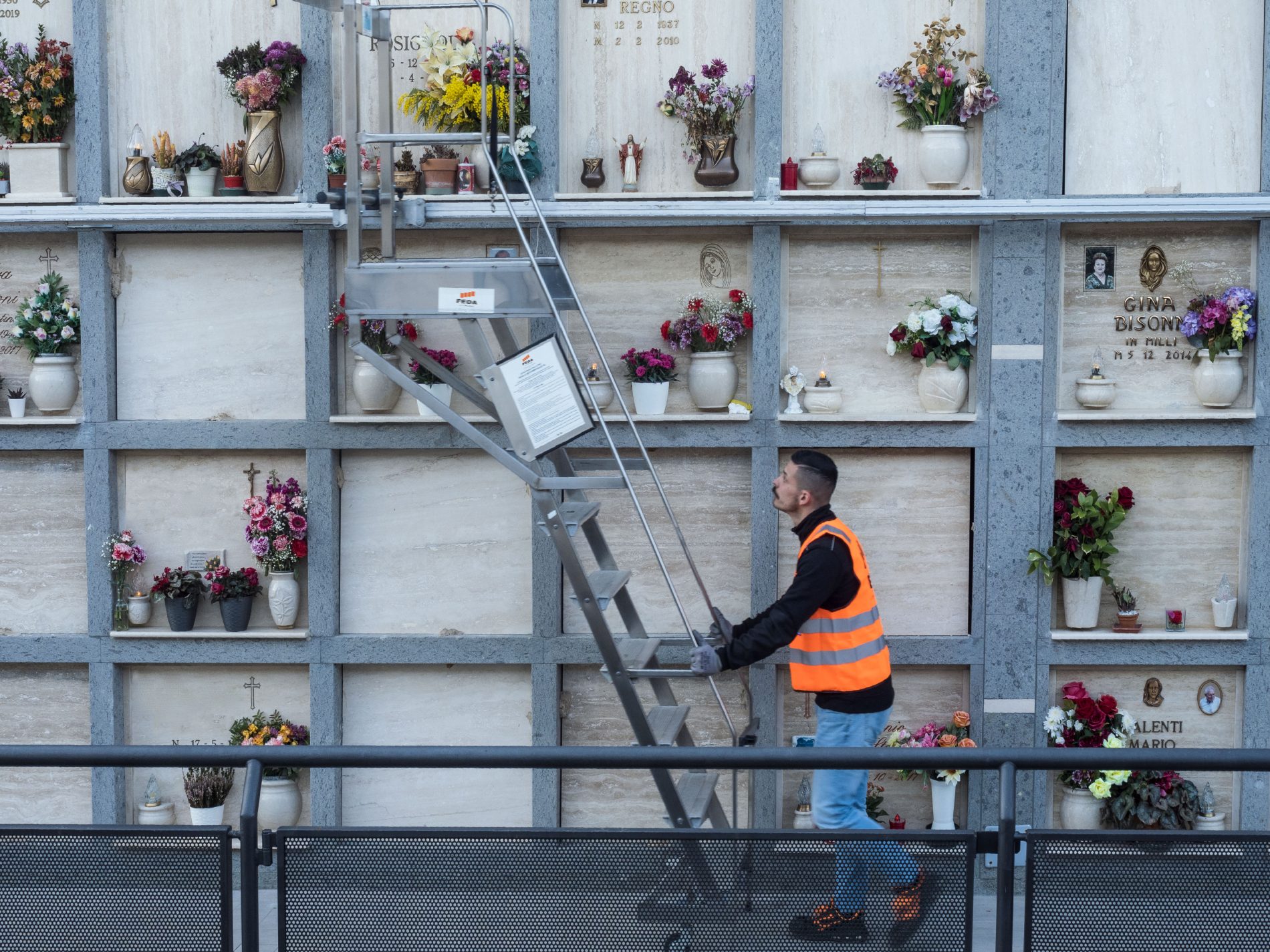Blog
Ladder safety with special reference to the cemetery sector

Portable ladders are understood as that tool, both professional and non-professional, that makes it possible to reach heights otherwise unreachable, except by other means.
Widely used equipment, therefore used by millions of people, they are subject to high accident risks as shown by INAIL statistics.
How many types of ladders exist and which are suitable for cemeteries?
The UNI EN 131-1 standard identifies portable ladders ‘by type’ according to their geometric configuration and constituent elements: Stand-up ladders, Double ladders, Convertible ladders, Multi-position ladders, Telescopic ladders, Movable ladders with platform.
For cemeteries, the most suitable are those with platforms, because they are more stable and have a comfortable platform with parapets on three sides.
An even more safety-oriented choice falls to sliding ladders with platforms, which we will discuss later.
It should be borne in mind that in some areas of cemeteries, especially monumental ones, there is not enough space to place a ladder with a platform, and therefore front-supported ladders with or without a sliding rail are chosen.
What are the regulations and relevant markings for cemetery ladders?
D.lgs. 81/08
UNI EN 131-1: 2015 – Ladders – Part 1: Terms, types, functional dimensions.
UNI EN 131-2: 2017 – Ladders – Part 2: Requirements, testing, marking.
UNI EN 131-7: 2013 – Ladders – Part 7: Movable ladders with platform.
UNI EN 14183: 2004 – Step stools.
A portable ladder that complies with d.lgs. 81/08 is not automatically also compliant with UNI EN 131, unless compliance with d.lgs. 81/08 has been declared by application of Annex XX of the same cited decree.
The manufacturer can declare compliance with legislative decree 81/08 in two ways:
- By demonstrating by calculation and/or testing, through the application of a product specification he deems most appropriate, that he has met the requirements of Art. 113;
- Declaring compliance with legislative decree 81/08 through the application of Annex XX (therefore also with UNI EN 131 part 1 and part 2).
It should be emphasised that since there is no product directive applicable to portable ladders, they cannot be CE marked, but must bear the UNI EN 131 marking and/or the reference to compliance with legislative decree 81/08, if they are used in a ‘non-workplace’ (UNI EN 131) or in a ‘workplace’ (UNI EN 131/d.lgs. 81/08).
What are the risks of using ladders in cemeteries?
Almost all of the ladders used in cemeteries to serve the pavilions in which the burial niches are located are of the ones with platform. The greatest dangers for visitors are represented by the fact that these ladders are freely transportable from one place to another in the cemetery, with the consequent possibility of accidents and injuries.
Let’s highlight a few characteristic points:
- Cemetery ladders, depending on their height and the materials from which they are constructed, can weigh from a few dozen kg to over 100 kg.
- The most commonly used model is the platform model, which has a rather narrow width (generally less than or slightly more than 1 metre) and a height of several metres. Therefore, they are not perfectly balanced.
- They are equipped with small, solid wheels, suitable for short journeys on paved and levelled surfaces. Because of this, they are unsuitable for transport on uneven, gravel-covered terrain, with kerbs, concrete elevations, grass surfaces, and uneven or even steep walking surfaces.
- People who have to carry ladders are often elderly, not in perfect health and therefore lack the strength necessary to push or hold them in the event of becoming unbalanced; even when they are young and healthy, it is not certain that they have sufficient skill and knowledge to perform the handling safely.
Consequently, from the combination of the factors mentioned in the four characteristic points, there are considerable risks not only of damage to ladders, but also of injury and damage to those who carry them or are near them.
How to choose the right cemetery ladder?
In the answers to the previous questions, we mentioned sliding ladders with platforms.
The classic sliding system is made of stabilised, non-self-supporting ladders, which therefore discharge their weight onto the sliding rails. Precisely because of this characteristic, in order to keep such systems intact, efficient and above all safe, periodic maintenance is advisable.
Feda, with its KOIME division dedicated entirely to the cemetery sector, designed and patented the SCROLL sliding system.
What is the SCROLL sliding system?
This system is used in combination with self-supporting bunk ladders, which are often found in cemeteries.
These ladders maintain their stability characteristics and therefore do not unload their weight onto the sliding rails (as in classic sliding systems) but onto the ground. This characteristic allows the weight of the ladder and of those using it not to weigh down, and therefore strain, on the rail which, being subjected to less stress, will maintain its integrity and therefore efficiency for a greater number of years.
The main difference in terms of usage lies in the fact that our system has been designed to allow ladders to remain anchored and movable even on sloped terrain. In fact, the special articulated arms of SCROLL guide the ladder during ascent and descent, ensuring it always rests on its four wheels. WATCH SCROLL’S VIDEO
Is it compulsory to carry out maintenance on cemetery stairs?
The answer is yes, but to support this assertion, reference should be made to the responsibilities of management and the particularity of the place where they are located, cemeteries.
It is the cemetery operator’s responsibility to protect the safety of visitors to the cemetery by reducing or eliminating all risks that could endanger their safety.
Given the type of visitors, mostly elderly and/or disabled, cemeteries qualify as sensitive areas subject to special protection conditions. Cemetery services, cemetery management and maintenance activities constitute a public service provided by the municipality.
The Municipality performs this service according to Article 113 of Legislative Decree 267/2000 and the more general provisions of Legislative Decree 36/2023 and subsequent amendments and/or supplements. Therefore, the municipal administration, according to the provisions of Article 2051 of the Civil Code, has an obligation to maintain and ensure the safety of the things it has in its custody and makes available to visitors (such as the cemetery stairs, for example).
On the subject of the cemetery operator’s liability, reference should also be made to Article 2043 of the Civil Code, ‘Compensation for an unlawful act’, according to which ‘Any wilful or negligent act that causes unjust damage to others, obliges the person who committed the act to compensate for the damage’. This provision also extends to and includes damage resulting from culpable conduct, which can also be attributed to merely omissive conduct. Such omissive behaviour is classified as ‘serious’ if the omission takes the form of failure to comply with legal prescriptions, thus recognising, in the case of an accident linked to the carelessness of the cemetery stairs, the injured party’s right to compensation from the cemetery manager.
The term ‘custody’ has a wide meaning that goes beyond the limits of mere possession. In fact, the custodian, whether owner or manager, is under an obligation to maintain and preserve it, such that no harm can be done in any way or use.
Who maintains the cemetery stairs?
It is necessary to rely on a company specialised in this type of work, which is able to issue a certificate of work carried out in a ‘workmanlike manner’, as well as timely reports on the work carried out stair by stair.
FEDA guarantees service and/or repair both for single interventions and for multi-year scheduled maintenance plans, for the latter, annual or lump-sum payments.
In order to address the interventions, in terms of quality and quantity, only on the staircases that need it, thus limiting the economic commitment, it is advisable to make use of our exclusive CHECK service, which involves a technical-maintenance analysis of the state of the cemetery staircases for the use of visitors. At the end of the service, a report is issued to the customer containing the total number of staircases checked, their state of maintenance, those to be taken out of service or in need of maintenance, and the possible need for numerical integration, based on the identified need.



